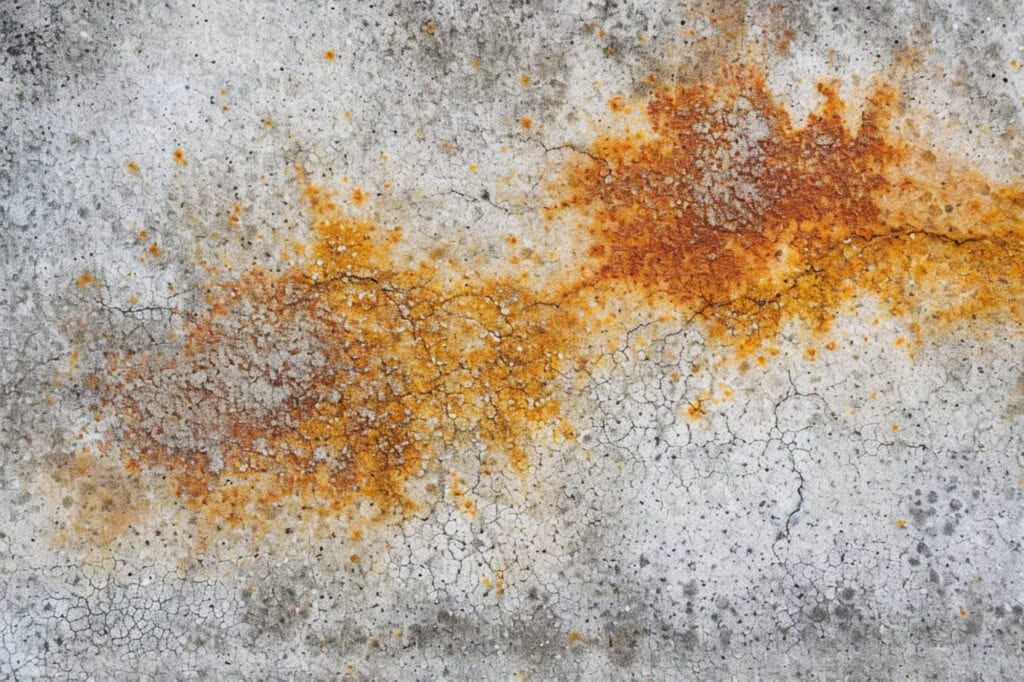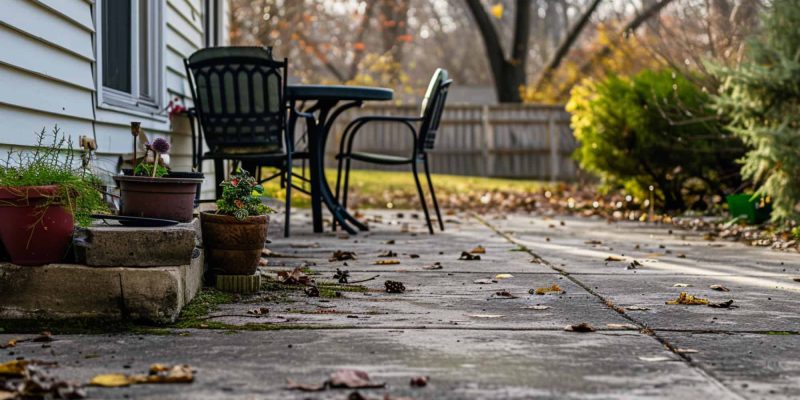Your patio is more than just a space; it’s an extension of your home, a place for gatherings, relaxation, and making memories. However, unsightly stains can diminish its appeal and functionality. Fret not! This guide is crafted to empower you with knowledge and skills to tackle and prevent patio stains, ensuring your outdoor haven remains as welcoming and beautiful as the rest of your home.
Understanding Different Types of Concrete Stains
Before diving into removal techniques, it’s crucial to understand the types of stains that commonly affect patios in Rockford, each with its unique challenges.
Oil and Grease Stains
Typically originating from cars or lawnmowers, these stains are common on driveways and garages. They appear as dark blotches, sometimes with a rainbow sheen. If left untreated, they can seep deep into your patio’s concrete, becoming more stubborn over time.
Rust Stains
These are usually the result of metal objects left on concrete, like patio furniture or garden tools. Characterized by their reddish-brown color, rust stains can be particularly noticeable and challenging to remove, especially after wet conditions accelerate the rusting process.
Organic Stains
Leaves, grass clippings, and natural debris often leave behind greenish or brownish discolorations. These organic materials can decompose on the concrete, leading to stains. Additionally, in shaded, damp areas, mold and mildew pose a slippery risk, manifesting as dark spots.
Paint and Chemical Stains
These stains can be the result of spillage during home improvement projects or accidental leaks. Their appearance varies based on the substance, with paint stains being particularly diverse depending on the type of paint (oil-based, latex, etc.).
DIY Guide to Removing Concrete Stains
Tackling concrete patio stains might seem intimidating, but with the right approach, you can effectively manage them. Let’s delve into a detailed guide for each type of stain.
Preparing Your Workspace
Safety first! Equip yourself with gloves, goggles, and old clothing to protect against harsh cleaning agents. Begin by sweeping away loose debris. A leaf blower can be handy for clearing the area. Choose a day with mild weather – too much sun can cause quick evaporation of cleaning solutions, while rain can dilute them.
Specific Removal Methods for Each Stain Type
Each stain type demands a tailored approach:
Oil and Grease Stains
Method: Start by absorbing excess oil with cat litter, sawdust, or baking soda. Let it sit for a few hours, then sweep it away. Apply a degreaser or a paste of baking soda and water. Scrub using a brush with stiff nylon bristles. Let it work its magic for a few hours, then rinse with a hose.
Why It Works: Degreasers dissolve the oil, while absorbents lift it off the concrete.
Rust Stains
Method: Saturate the rust stain with undiluted white vinegar or lemon juice. Allow it to soak in for about 20 minutes. Scrub with a nylon brush and rinse thoroughly. For persistent stains, commercial rust removers are available, but they should be used with caution and according to the manufacturer’s instructions.
Why It Works: The acidic nature of vinegar or lemon juice breaks down the rust, making it easier to scrub away.
Organic Stains
Method: Create a mixture of one part bleach to three parts water for mold, mildew, or leaf stains. Apply it to the stain, let it sit for about 15 minutes, then scrub vigorously. Rinse thoroughly. Ensure good ventilation if working in a confined space.
Why It Works: Bleach is a powerful agent against organic material, effectively removing these stains and killing mold spores.
Paint and Chemical Stains
Method: For water-based paints, use a solution of dish soap and warm water. Apply, scrub, and rinse. For oil-based paints or stubborn chemical stains, apply a commercial paint stripper or thinner, following safety instructions. Scrub and rinse thoroughly.
Why It Works: Soap and water can handle water-based stains, while chemical solvents are effective against tougher, oil-based substances.
Additional Tips
- Conduct a small patch test with your chosen cleaning solution to ensure it doesn’t damage the concrete.
- A pressure washer can be a valuable tool for stubborn stains, but it should be used with caution to avoid damaging the concrete.
- For deep or old stains, multiple treatments might be necessary.
Advanced Tips for Stubborn Stains

When faced with particularly stubborn concrete stains, standard methods might not suffice. Here are some advanced tips and techniques to tackle these challenging stains.
Power Washing Techniques
Power washing can be a game-changer for difficult stains. Here’s how to use it effectively:
- Opt for a power washer with at least 3000 psi for maximum efficiency.
- Attach a fan-tip nozzle to evenly distribute pressure and minimize surface damage.
- Start washing from a higher distance, gradually moving closer to the concrete, maintaining about 12-18 inches distance.
- Apply a concrete detergent for tough stains, allowing it to sit for 10-15 minutes before power washing. This pre-treatment can significantly enhance the cleaning power.
- Move the washer in a consistent, sweeping motion to avoid streaking.
- Always wear protective gear, including eye protection and closed-toe shoes.
Professional Grade Products
For the most tenacious stains, like heavy oil or deep-set rust, consider professional-grade cleaning products. These are formulated with stronger chemicals and require careful handling:
- Read and follow the product instructions meticulously.
- Use personal protective equipment, including gloves and safety goggles.
- Ensure adequate ventilation if you’re working in a garage or a similar enclosed area.
- Be mindful of the environmental impact and dispose of any runoff or residue responsibly.
Expert Assistance
If all else fails, or if you’re dealing with a particularly large or delicate area, seeking professional help is a wise choice. Professionals have access to industrial-grade equipment and specialized knowledge to handle difficult stains without damaging the concrete patio.
Patience and Persistence
Dealing with tough stains often requires patience:
- Some stains may lighten but not disappear completely after the first treatment. Repeat applications can gradually diminish the visibility of the stain.
- Combining methods (like applying a cleaner followed by power washing) can also be effective.
Preventive Measures to Avoid Concrete Stains
Preventive care is the most effective strategy to keep your patio’s concrete surfaces pristine. Here are some comprehensive measures to help you avoid the hassle of stain removal:
Expanded Regular Maintenance
One of the most straightforward yet effective ways to prevent stains is through routine cleaning. Regular sweeping and hosing down your concrete patio plays a crucial role in preventing the accumulation of substances that could lead to stains.
Establishing a weekly habit of cleaning your patios can make a significant difference. Additionally, immediate action on spills is vital. When accidents happen, quickly absorbing liquids with rags or paper towels and following up with a mild detergent can prevent many stains from setting in, preserving the look of your concrete.
Protective Coatings and Sealants
An essential step in stain prevention is the application of protective coatings and sealants. These products come in various types, including acrylic, epoxy, and penetrating sealers. The choice of sealant should be based on your concrete’s exposure to elements and the amount of foot or vehicle traffic it receives.
For instance, a penetrating sealer is ideal for high-traffic areas due to its durable protection. The application of these sealants should be on clean, dry concrete, following the manufacturer’s guidelines, which typically involves using a roller or sprayer. Regular maintenance of these sealants, including reapplication every few years, is crucial to maintain their protective properties. Signs of water absorption or wear and tear indicate that it’s time for a new coat.
Quick Response to Spills
Being equipped for emergencies, especially in areas prone to spills like garages, is also essential. Keeping a spill response kit, which might include absorbents, degreasers, and cleaning cloths, nearby can be a game-changer in preventing stains. When tackling spills, the technique matters – blotting is more effective than rubbing, which can drive the stain deeper into the concrete.
Conclusion
Regular maintenance, effective stain removal techniques, and preventive measures will keep your outdoor space looking fresh and inviting. Remember, a well-cared-for patio not only enhances the aesthetic appeal of your home but also serves as a place for relaxation and enjoyment. Embrace the responsibility of patio care with confidence and pride, knowing that your efforts will create a welcoming and beautiful space for years to come. Happy cleaning, and enjoy your pristine patio in Rockford!

